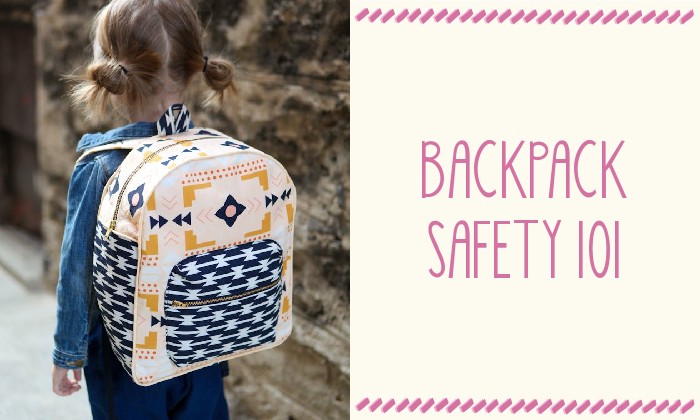
 Post Category - ParentingParenting - Post Category - 5-11 Year Olds5-11 Year Olds - Post Category - Tweens & TeensTweens & Teens
Post Category - ParentingParenting - Post Category - 5-11 Year Olds5-11 Year Olds - Post Category - Tweens & TeensTweens & Teens Post Category - Health & WellnessHealth & Wellness - Post Category - WellnessWellness
Post Category - Health & WellnessHealth & Wellness - Post Category - WellnessWellnessBackpacks are the most common school bags used by students today. They’re available in an infinite variety of shapes, sizes, colours and materials. Prices can range from inexpensive to downright outrageous, yet the basic overall design is the same: two shoulder straps attached to a main “bag” that one wears on their back. When fitted and worn properly, they are incredibly effective transport tools. Compared to messenger bags, hand held luggage or purses, backpacks are by far the better choice, mainly because the weight of the pack is supported by some of the body’s strongest muscles, the abdominal and back muscles. A properly worn backpack is designed to dissipate the weight of the carried items evenly across the body, minimizing the risk of neck and shoulder injuries.
Even though backpacks are generally regarded as safe, they can still cause injury if they are too heavy or used improperly.

Backpack Related Problems
Many children suffer from pain because of their backpacks. They carry around their entire locker’s contents with them all day long. As they get tired, muscle fatigue occurs leading to spinal instability and higher risk of injury. It is recommended that children carry no more than 10% of their body weight in their backpacks. Just by observing the average primary student in Hong Kong it is obvious that this recommendation is often ignored. When a backpack is too heavy, to prevent falling backwards, the child must compensate by hunching the upper back and hips forward. This places a ton of stress on the muscles that run parallel along the spine. The discs in between the vertebrae also experience increased stress. This poor forward posture can result in permanent changes to the shape of the spine leading to health problems further down the road.
Many children wear their backpacks using only one shoulder strap. This is often due to laziness or as a fashion statement. Because all the weight will be concentrated on one shoulder, the child will need to lean sideways to the opposite shoulder to prevent the backpack from slipping off. This will cause the spine to be “bent” to one side. Over the course of time, especially during growing periods, many researchers believe that this can lead to permanent fixations in the spine. In other words, the spine will alter it’s shape to adapt to the forces acting on it. This can give rise to muscle imbalances, uneven stresses on the joints of the spine and eventual pain and tissue damage.
Backpacks with narrow, non-cushioned shoulder straps can compress anatomical structures in the region including nerves and blood vessels, resulting in poor circulation, numbness and weakness to both arms and hands.
Choosing A Proper Backpack
Children will likely choose a backpack based solely on its appearance and coolness factor. As a parent it is important to ensure that the backpack has certain features that will maximise comfort while minimising the risk of injury.
First off, the backpack should be the proper size for a child. Avoid buying an adult size backpack for a child. The fit will be too loose and lead to a higher risk of injury. The backpack should have multiple compartments. This gives more options to distribute the weight evenly. A waist and sternum belt will help to add more stability to the backpack by keeping the weight closer to the body. There should be 2 shoulder straps. Each strap should be wide and padded for increased comfort. Skinny straps as mentioned, can dig into the shoulders causing pain and discomfort. The backpack should have a thick padded backing which will help to protect the child from being poked by sharp items (ie. rulers, book corners, pens, etc.) .
Many of the newer backpack are equipped with pull handles and rolling wheels. This is great if the child has to haul heavier items but may be affected by uneven terrain or heavy snow.
Finally, parents should consider backpacks that are made from lightweight materials. Heavy fabrics or leather will add unnecessary weight. Always remember to place an emphasis on function over aesthetics.

Proper Backpack Use
Remember that the maximum load carried should only be 10% of your child’s body weight. Weigh the backpack on a bathroom scale to verify this. Heavier items should be placed at the bottom and towards the backing, closer to the body. The waist and both shoulder straps should be used at all times. Ensure that the straps are tight enough so that the backpack rests completely against the child’s body with no space in between. The backpack should be the length of the torso. The bottom should be approximately 2 inches below the waist and not sag down to the buttocks.
What Actions Can My Child Take?
There are a few things your child can do to lessen the chance of a backpack related injury. Parents should remind their child to bring home only those books needed for homework or studying. Make sure they don’t carry unnecessary items that can add extra pounds to their pack.
Teachers should remind students to regularly use their lockers throughout the day instead of carrying everything around with them.
When picking up a backpack, remember to bend at the knees and not at the waist. Use both hands to hold the backpack and lift primarily with the legs, making sure to keep the pack between the shoulders and tight against the body.
 View All
View All











 View All
View All





 View All
View All


 View All
View All










